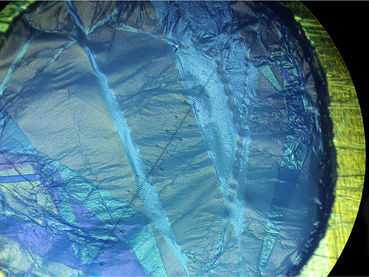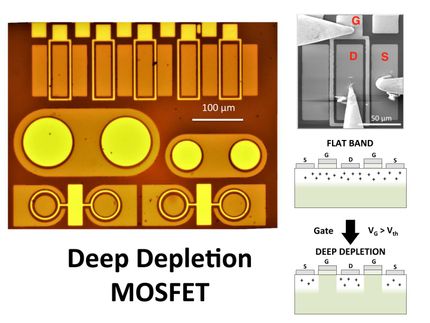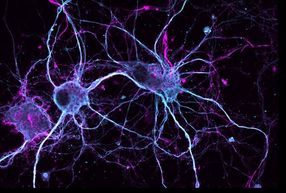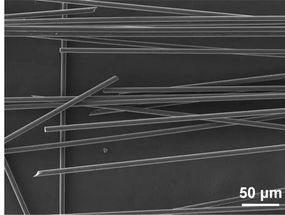Organic electronics: Semiconductors as decal stickers
No more error-prone evaporation deposition, drop casting or printing: Scientists at Ludwig-Maximilians-Universitaet (LMU) in Munich and FSU Jena have developed organic semiconductor nanosheets, which can easily be removed from a growth substrate and placed on other substrates.

A 50nm pentacene film spanned across a 2 mm hole.
Simon Noever, LMU
Today's computer processors are composed of billions of transistors. These electronic components normally consist of semiconductor material, insulator, substrate, and electrode. A dream of many scientists is to have each of these elements available as transferable sheets, which would allow them to design new electronic devices simply by stacking.
This has now become a reality for the organic semiconductor material pentacene: Dr. Bert Nickel, a physicist at LMU Munich, and Professor Andrey Turchanin (Friedrich Schiller University Jena), together with their teams, have, for the first time, managed to create mechanically stable pentacene nanosheets.
They first cover a small silicon wafer with a thin layer of a water-soluble organic film and deposit pentacene molecules upon it until a layer roughly 50 nanometers thick has formed. The next step is crucial: by irradiation with low-energy electrons, the topmost three to four levels of pentacene molecular layers are crosslinked, forming a "skin" that is only about five nanometers thick. This crosslinked layer stabilizes the entire pentacene film so well that it can be removed as a sheet from a silicon wafer in water and transferred to another surface using ordinary tweezers.
Apart from the ability to transfer them, the new semiconductor nanosheets have other advantages. The new method does not require any potentially interfering solvents, for example. In addition, after deposition, the nanosheet sticks firmly to the electrical contacts by van der Waals forces, resulting in a low contact resistance of the final electronic devices. Last but not least, organic semiconductor nanosheets can now be deposited onto significantly more technologically relevant substrates than hitherto.
Of particular interest is the extremely high mechanical stability of the newly developed pentacene nanosheets, which enables them to be applied as free-standing nanomembranes to perforated substrates with dimensions of tens of micrometers. That is equivalent to spanning a 25-meter pool with plastic wrap. "These virtually freely suspended semiconductors have great potential," explains Nickel. "They can be accessed from two sides and could be connected through an electrolyte, which would make them ideal as biosensors, for example". "Another promising application is their implementation in flexible electronics for manufacturing of devices for vital data acquisition or production of displays and solar cells," Turchanin says.
Original publication
Simon J. Noever, Michael Eder, Fabio del Giudice, Jan Martin, Franz Werkmeister, Stefan Hallwig, Stefan Fischer, Oliver Seeck, Nils-Eike Weber, Clemens Liewald, Fritz Keilmann, Andrey Turchanin und Bert Nickel; "Transferable organic semiconductor nanosheets for application in electronic devices"; Advanced Materials; 2017
Original publication
Simon J. Noever, Michael Eder, Fabio del Giudice, Jan Martin, Franz Werkmeister, Stefan Hallwig, Stefan Fischer, Oliver Seeck, Nils-Eike Weber, Clemens Liewald, Fritz Keilmann, Andrey Turchanin und Bert Nickel; "Transferable organic semiconductor nanosheets for application in electronic devices"; Advanced Materials; 2017
Topics
Organizations
Other news from the department science

Get the chemical industry in your inbox
By submitting this form you agree that LUMITOS AG will send you the newsletter(s) selected above by email. Your data will not be passed on to third parties. Your data will be stored and processed in accordance with our data protection regulations. LUMITOS may contact you by email for the purpose of advertising or market and opinion surveys. You can revoke your consent at any time without giving reasons to LUMITOS AG, Ernst-Augustin-Str. 2, 12489 Berlin, Germany or by e-mail at revoke@lumitos.com with effect for the future. In addition, each email contains a link to unsubscribe from the corresponding newsletter.






















































